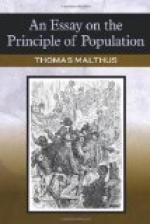By great attention to cleanliness, the plague seems at length to be completely expelled from London. But it is not improbable that among the secondary causes that produce even sickly seasons and epidemics ought to be ranked a crowded population and unwholesome and insufficient food. I have been led to this remark, by looking over some of the tables of Mr Suessmilch, which Dr Price has extracted in one of his notes to the postscript on the controversy respecting the population of England and Wales. They are considered as very correct, and if such tables were general, they would throw great light on the different ways by which population is repressed and prevented from increasing beyond the means of subsistence in any country. I will extract a part of the tables, with Dr Price’s remarks.
IN THE KINGDOM OF PRUSSIA, AND DUKEDOM OF LITHUANIA
Proportion
Proportion
Births Burials Marriages of Births
to of Births to
Marriages
Burials
10 Yrs to 1702 21,963 14,718 5,928 37 to
10 150 to 100 5 Yrs to 1716 21,602 11,984
4,968 37 to 10 180 to 100 5 Yrs to 1756
28,392 19,154 5,599 50 to 10 148 to 100
“N.B. In 1709 and 1710, a pestilence carried off 247,733 of the inhabitants of this country, and in 1736 and 1737, epidemics prevailed, which again checked its increase.”
It may be remarked, that the greatest proportion of births to burials, was in the five years after the great pestilence.
DUCHY OF POMERANIA
Proportion Proportion Annual Average Births Burials Marriages of Births to of Births to Marriages Burials 6 yrs to 1702 6,540 4,647 1,810 36 to 10 140 to 100 6 yrs to 1708 7,455 4,208 1,875 39 to 10 177 to 100 6 yrs to 1726 8,432 5,627 2,131 39 to 10 150 to 100 6 yrs to 1756 12,767 9,281 2,957 43 to 10 137 to 100
“In this instance the inhabitants appear to have been almost doubled in fifty-six years, no very bad epidemics having once interrupted the increase, but the three years immediately follow ing the last period (to 1759) were so sickly that the births were sunk to 10,229 and the burials raised to 15,068.”
Is it not probable that in this case the number of inhabitants had increased faster than the food and the accommodations necessary to preserve them in health? The mass of the people would, upon this supposition, be obliged to live harder, and a greater number would be crowded together in one house, and it is not surely improbable that these were among the natural causes that produced the three sickly years. These causes may produce such an effect, though the country, absolutely considered, may not be extremely crowded and populous. In a country even thinly inhabited, if an increase of population take place, before more food is raised,




